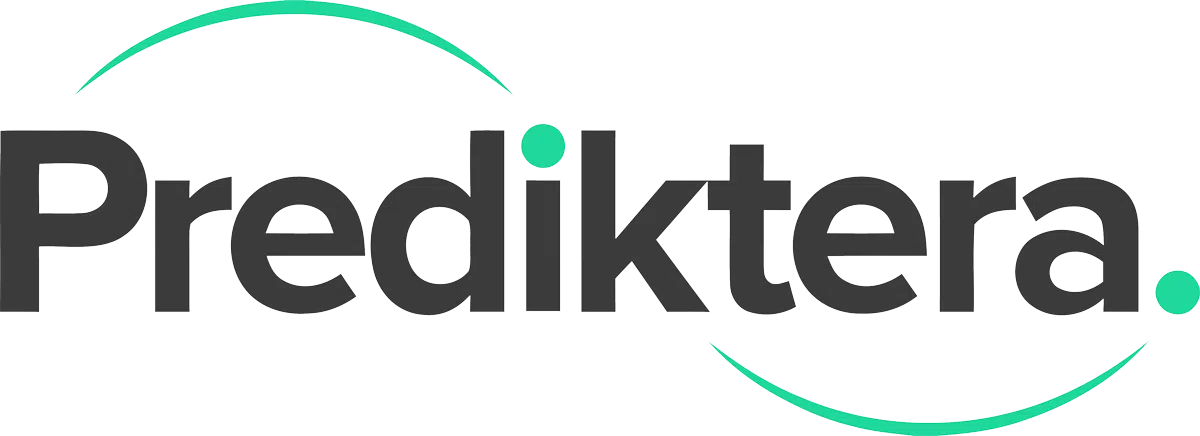In this session, we'll use the same images as in the tutorial “Intro to Breeze: Classification of nuts step 1” but add a new class variable to classify the type of nut. You will also test two classification models types (PLS-DA, SIMCA).
If this is new to you, we recommend you to go through step 1 first. Intro to Breeze: Classification of nuts step 1
Steps included in the tutorial
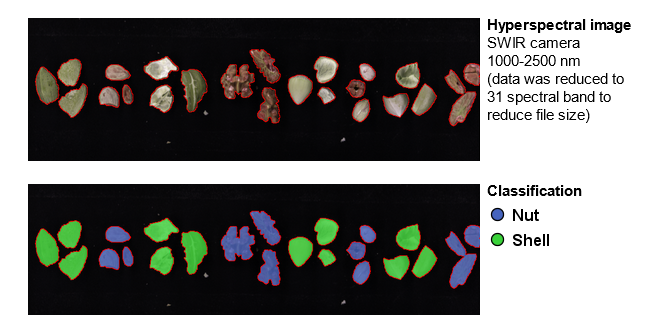
Import known class information to samples
Open up Analyser tool.
For this tutorial, use the project Nuts_Classification.

Select the study called “Nuts_classification” and
Press “Table” tab
Select “Sample - Nuts_Classification” in drop-down menu called Segmentation located under the table.
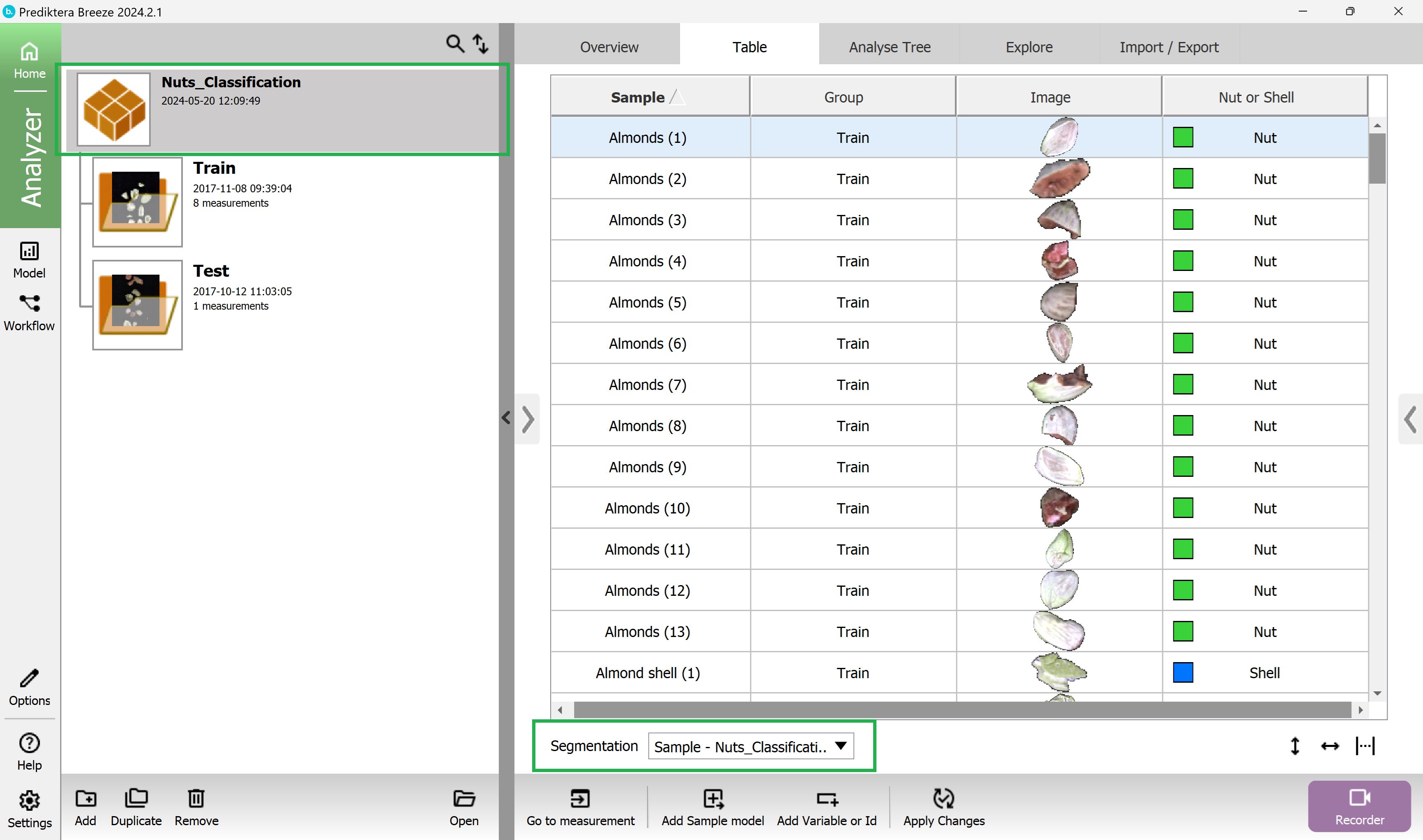
Import the “true values” to be able to model and predict data later.
Press the “Import/Export” tab
For this tutorial, we already classified the true values in the previous step. So now we need to fetch those files.
Select “Import variables and id data
Press Next
Choose Nuts_Classification_Train.CSV
Press Next
For this tutorial leave un-changed.
For other use, choose the correct segmentation to import.
Press Finish.
In the Table view, you should see the new “Nut type” class variable that was imported. The reference values were automatically matched with the correct sample object.
The spreadsheet .CSV file that you imported looks like this when opened in Excel. The column “Measurement” matches the class data (“Nut or shell” and “Nut type”) to the correct images and samples.

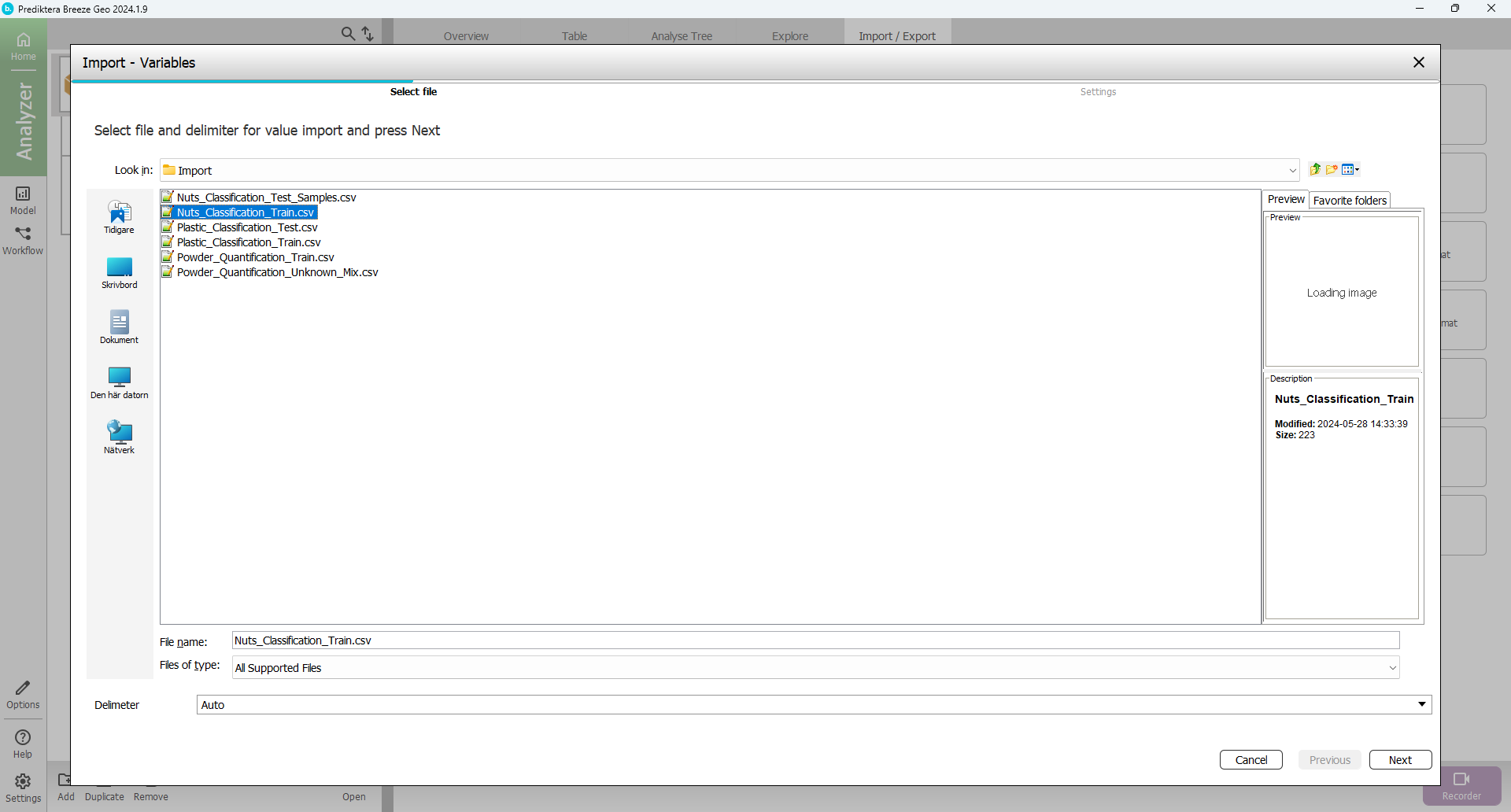
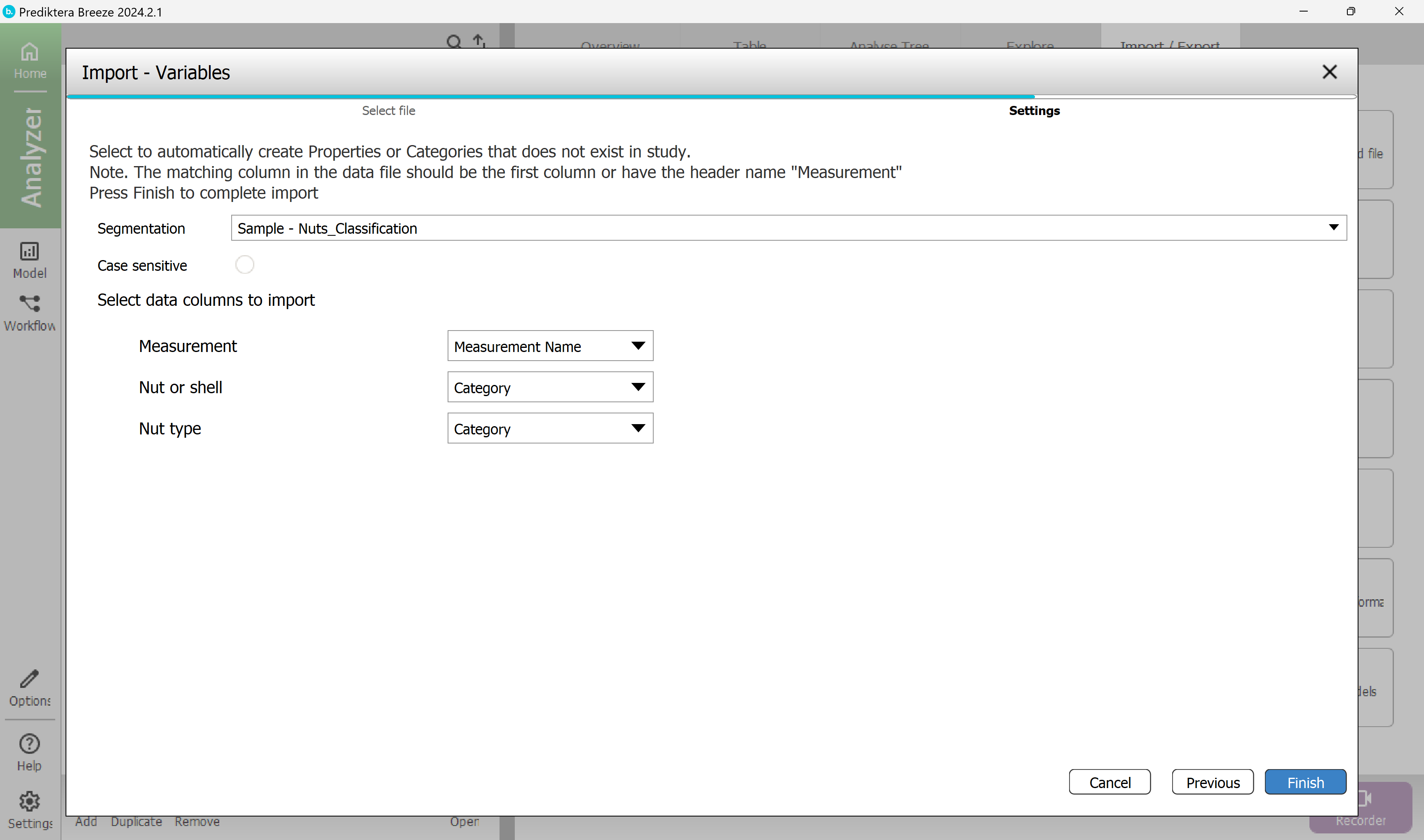
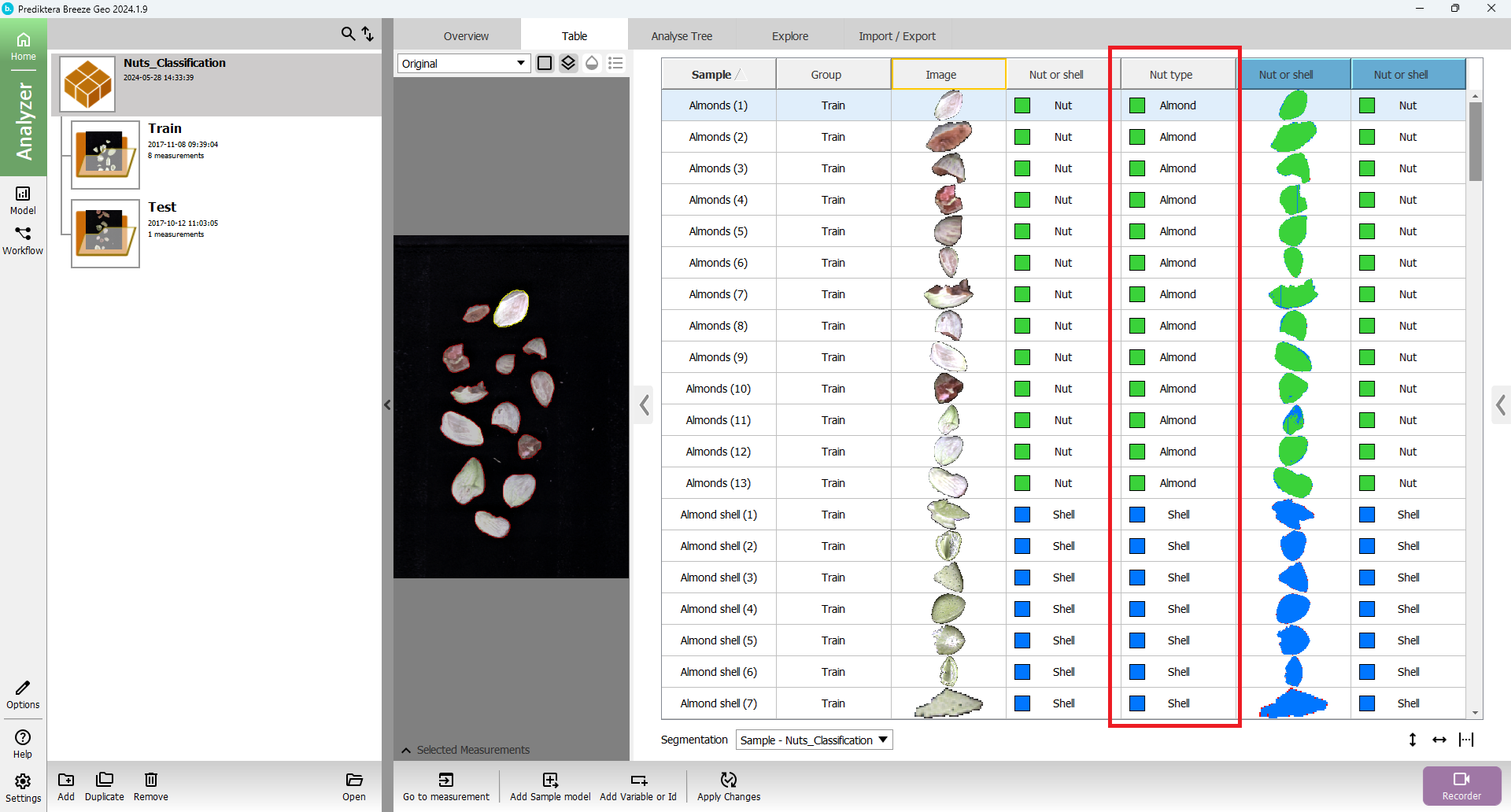
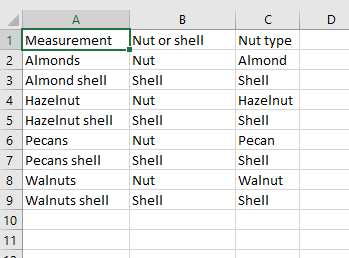
Press the “Explore” tab and then on the right side menu under “Color” select “Nut type” to see how the different types cluster
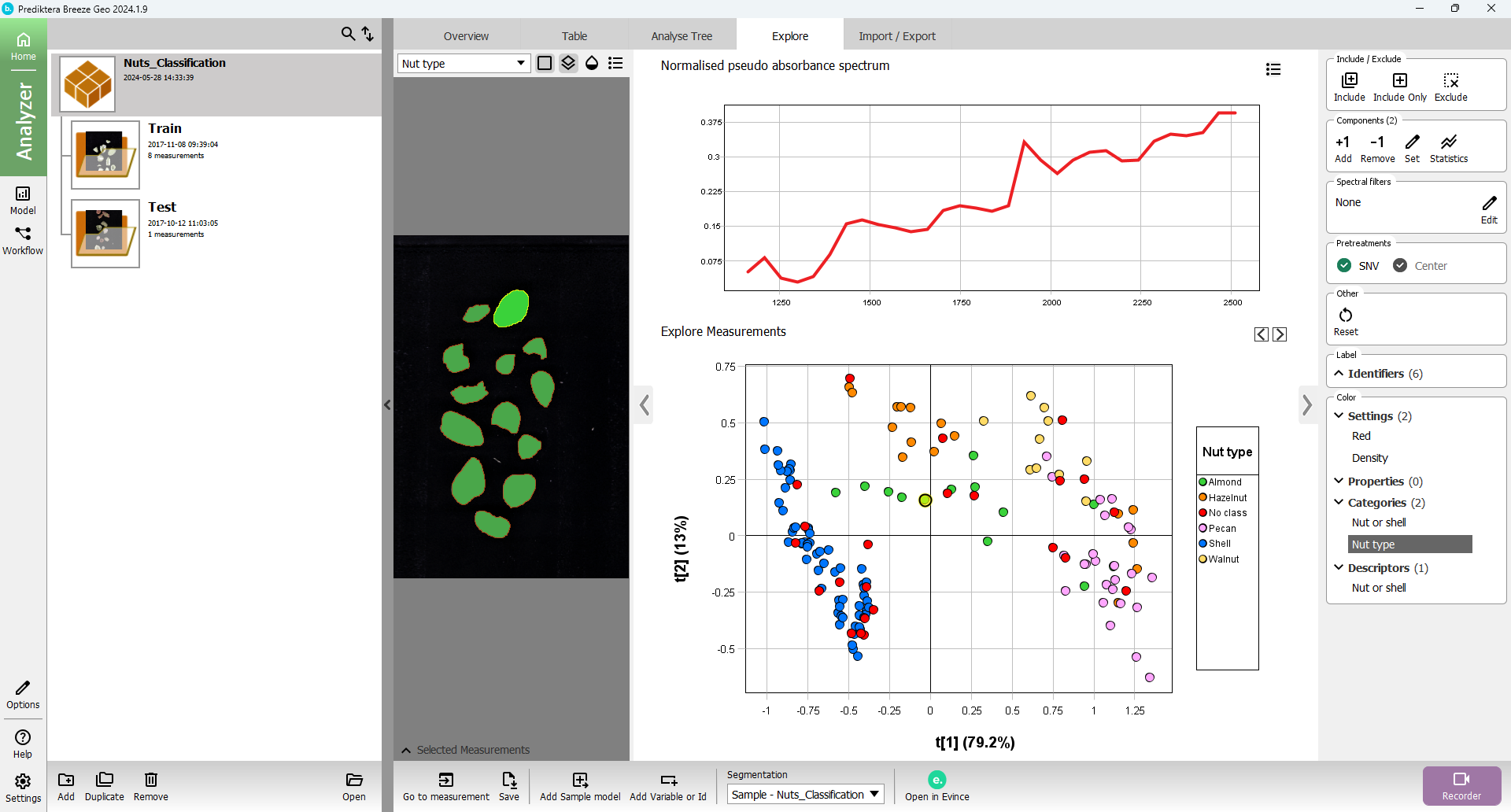
Create classification model (PLS-DA)
Now you will create a Classification model for “Nut type”.
Press “Model”

Press Add to make a new model.
Click on PLS-DA Classification.
Write a name or use the default one.
Press OK.
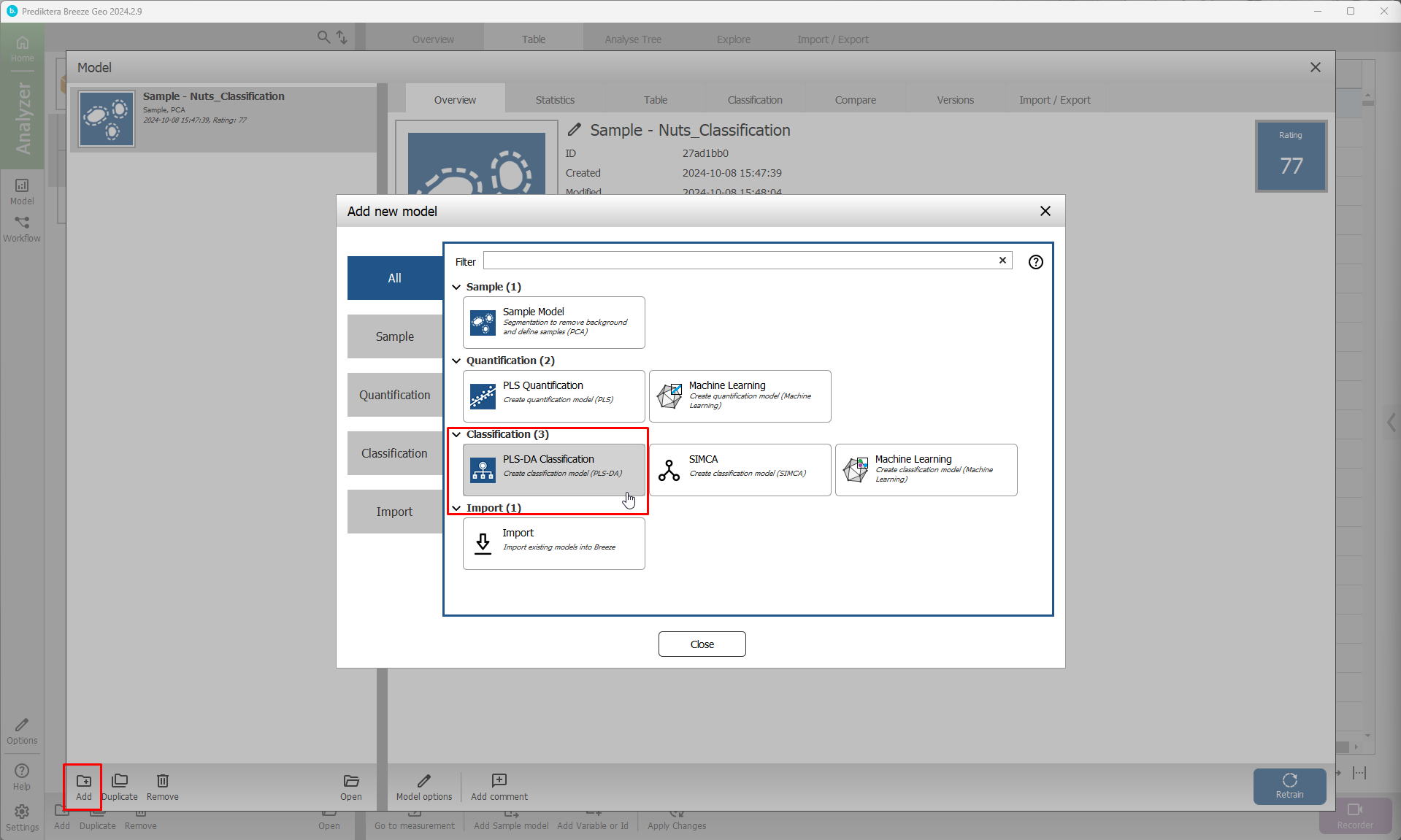
A wizard will be visible
Step 1 - Variables: Choose the “Nut type” category
press “Next”
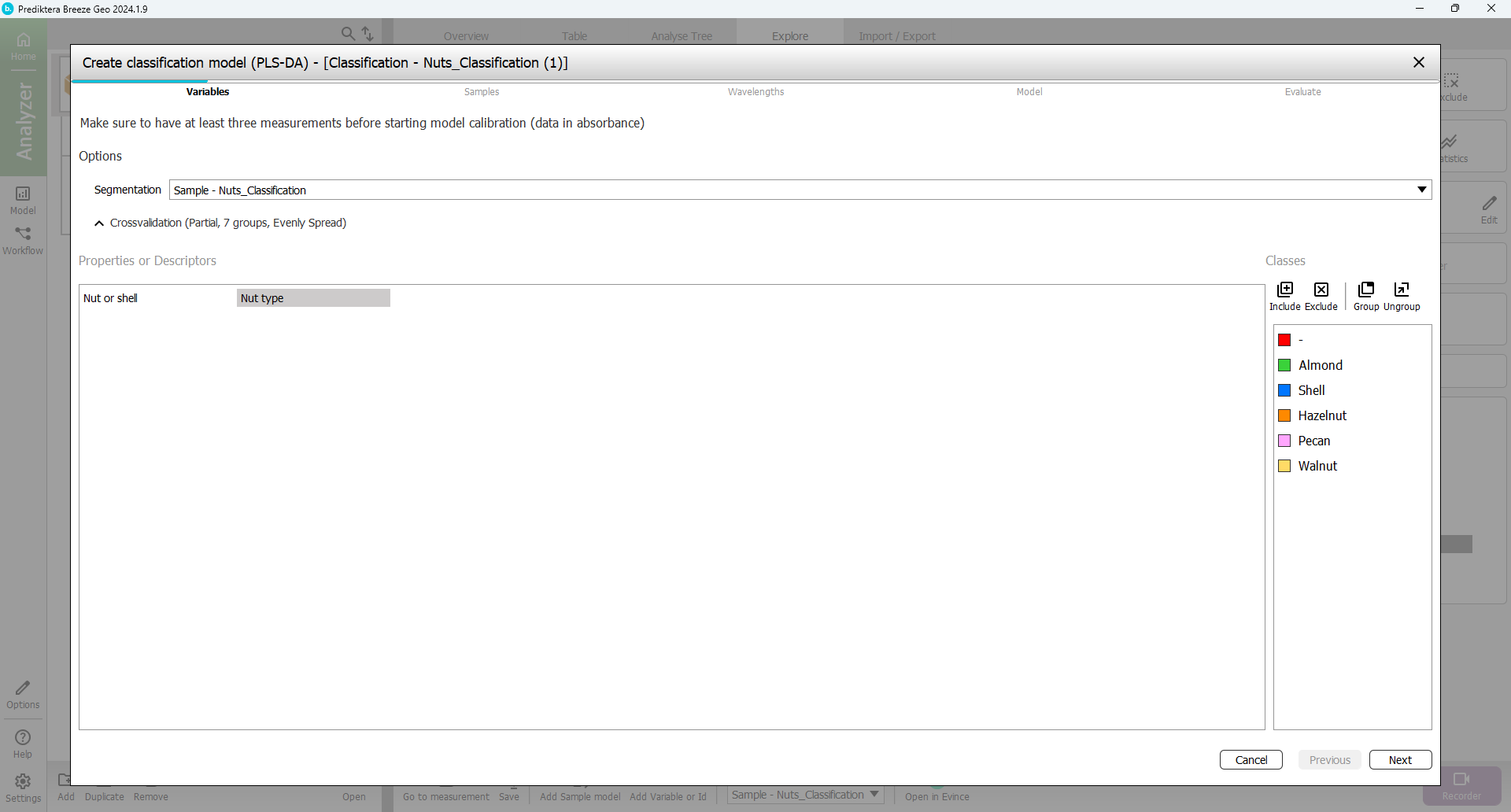
For this tutorial: In the 2nd and 3rd steps of the model wizard just press “Next” (use the default) so that you come to the 4th step (“Model”).
Step 4 Model:
In the “Overview (total for all Y)” you should have 6 components for your PLS-DA model.
Under “Components” you can press “Add”
to add more components to the PLS-DA model (to a total of 6, i.e. 6 red and 6 blue bars).
In the “Overview (total for all Y)” you can see that the model has a R2=0.77 and Q2=0.73 by hovering the mouse over the bars.
Press “Next”.
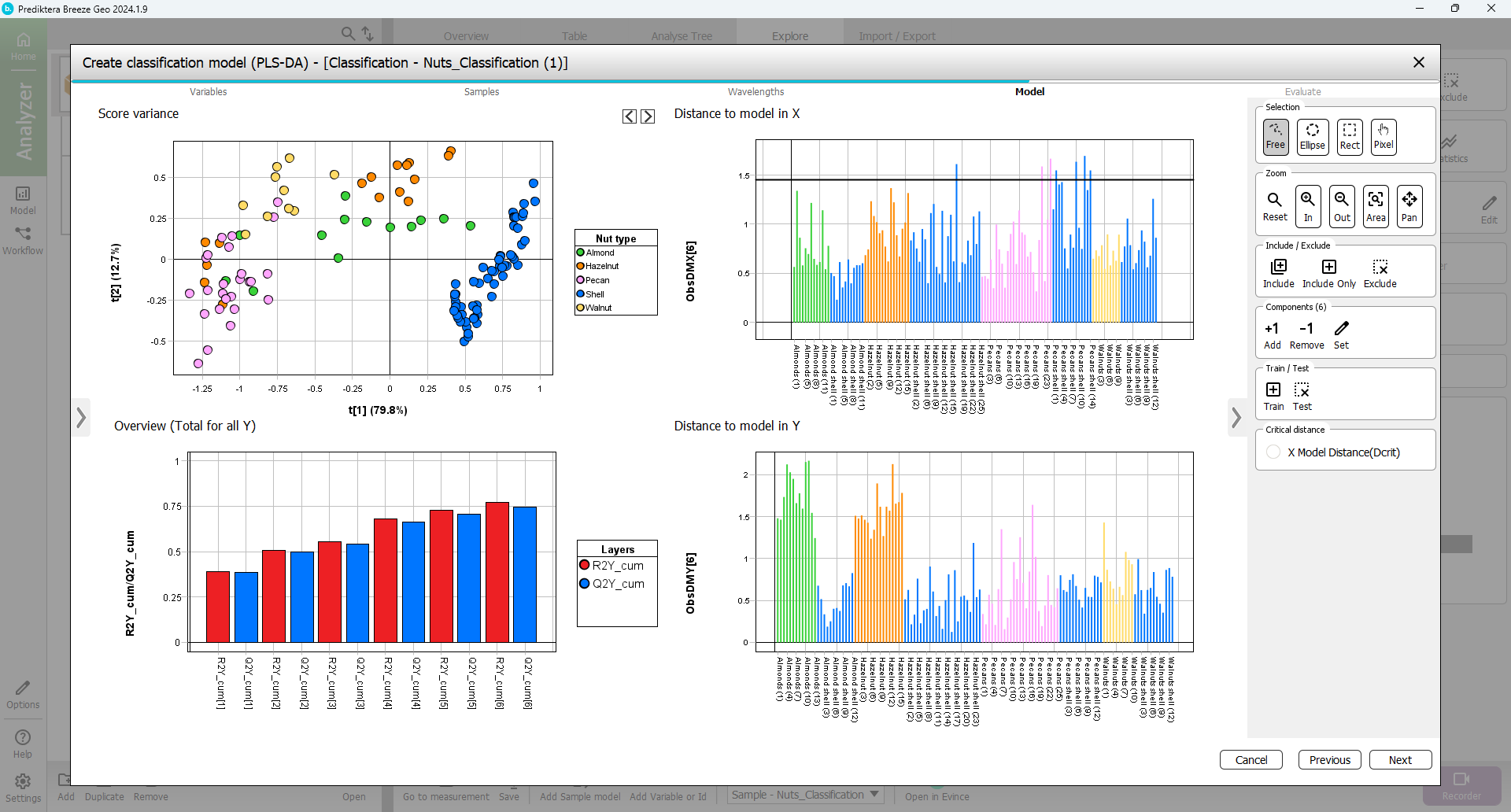
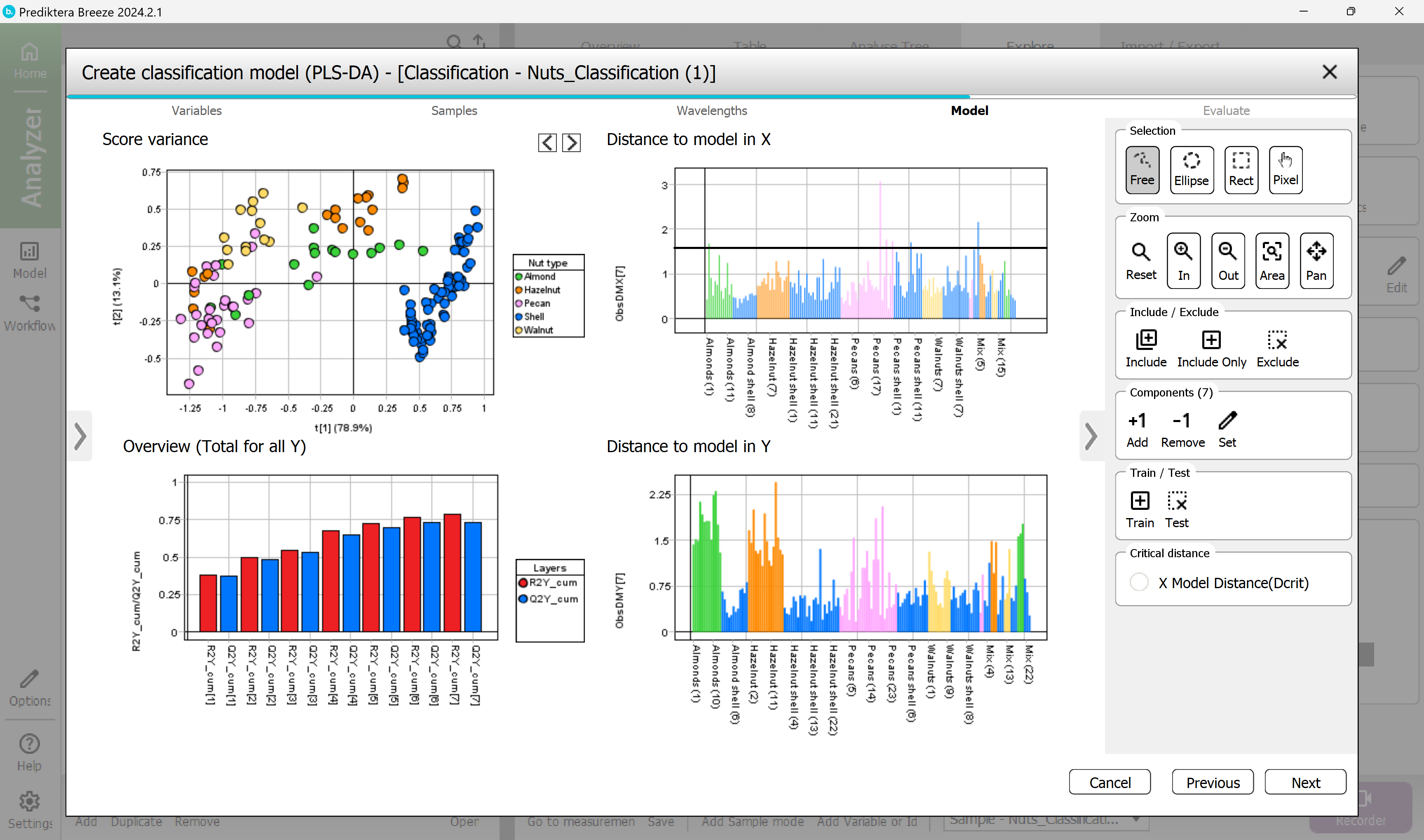
In the last step 5 - Evaluate:
you can see the class separation by pressing the tabs for the different classes under the “Observed vs Calculated” plot. The “Variable overview” graph shows that Almond and Hazelnut could not be classified as well as the other types.
Press Finish.
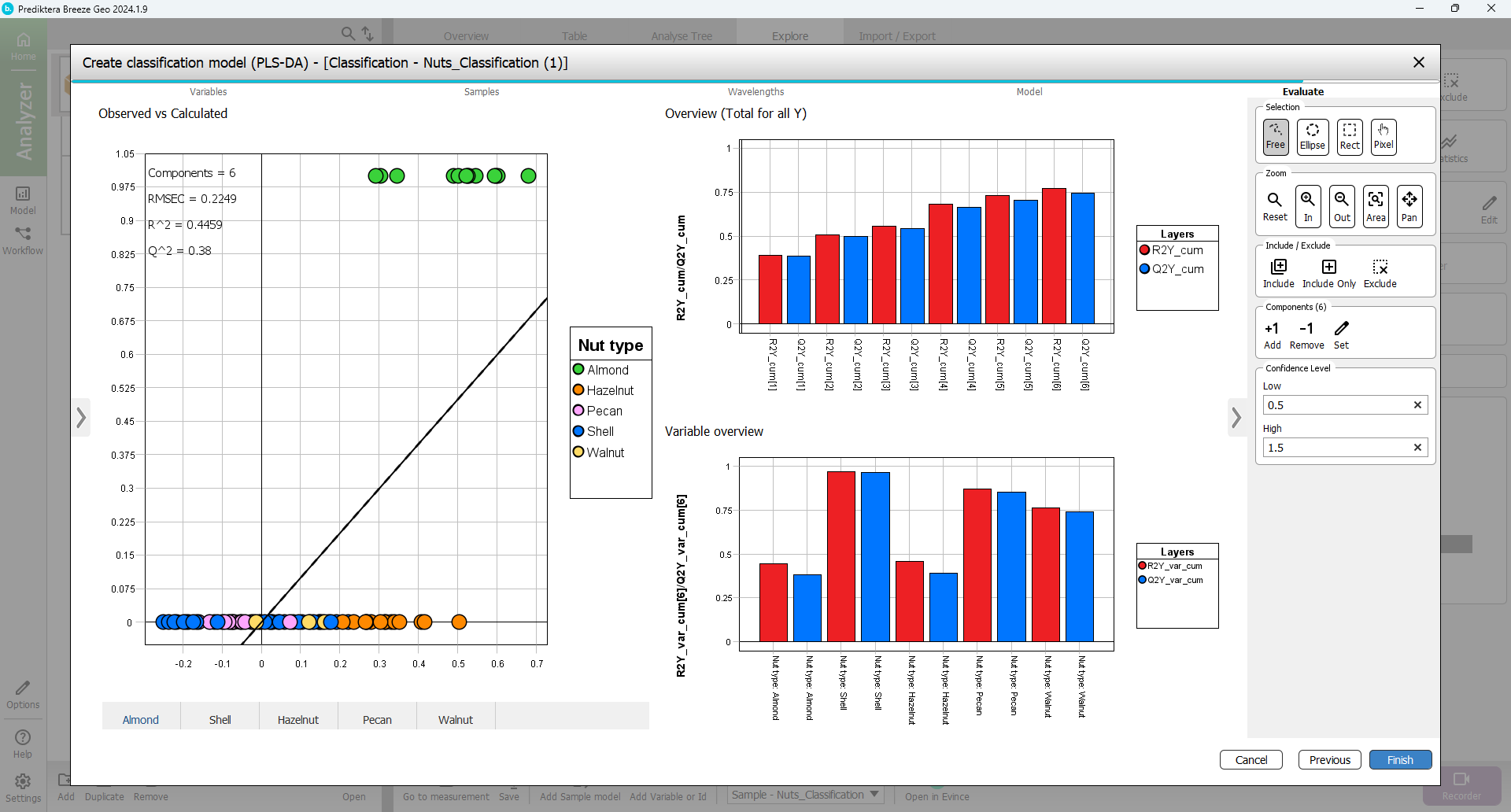
Press the “Classification” tab to see how well the training data was classified by the PLS-DA model (the results might vary slightly depending on how you did your sample model).
In this example, 3 of the “Almond” samples are misclassified as a “Hazelnut” and 3 as “No class”. For the “Hazelnut” there are 8 samples that are incorrectly classified as “No class”.
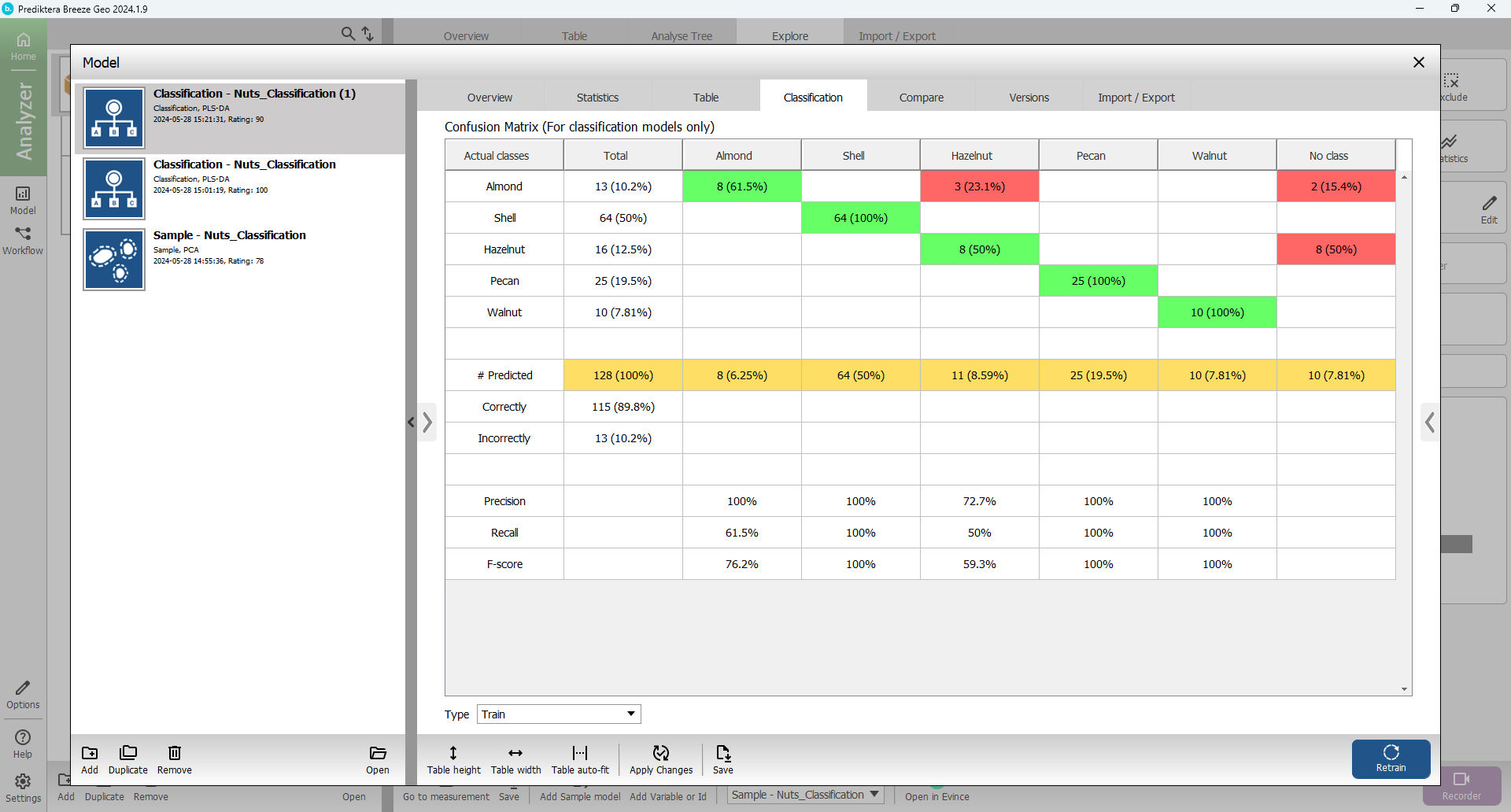
Create classification model (SIMCA)
Let’s compare the PLS-DA model with a different classification model type.
Press “Add”
Select “SIMCA”
Choose a name - write a name for the model or use default.
Press OK.
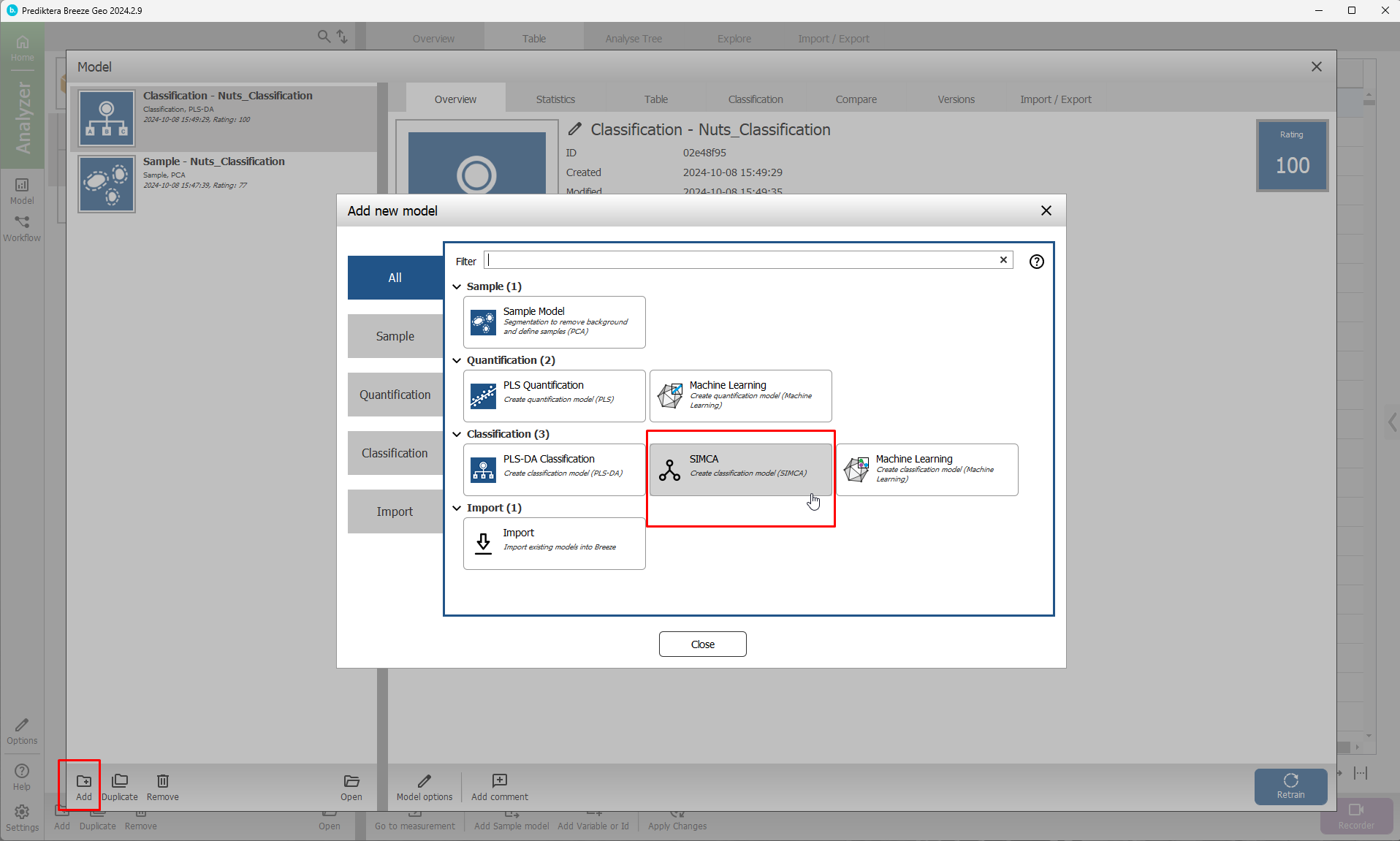
Choose “Nut type”

In the 2nd and 3rd steps just press “Next” (use the default).
In the SIMCA method,
one PCA model is created for each class.
All samples are then compared to that class model to determine if they belong to that class. In the Coomans plot, you can set the critical distance for each class model. If a sample is inside the critical distance it belongs to the class.
a) Select the class model for “Almond” by using the tabs under the Coomans plot
b) Drag the vertical red line to adjust the limit to include all “Almond” samples (but as few as possible of the other samples). Samples to the left of the red line are included in the Almond model.
Press the tab for each of the classes and repeat the steps in a) and b)
(“Overview (Total for all Y)” is only showing how well each class model can explain the samples in that class. It does not show how well it can classify other samples)
Press “Finish” to complete the model
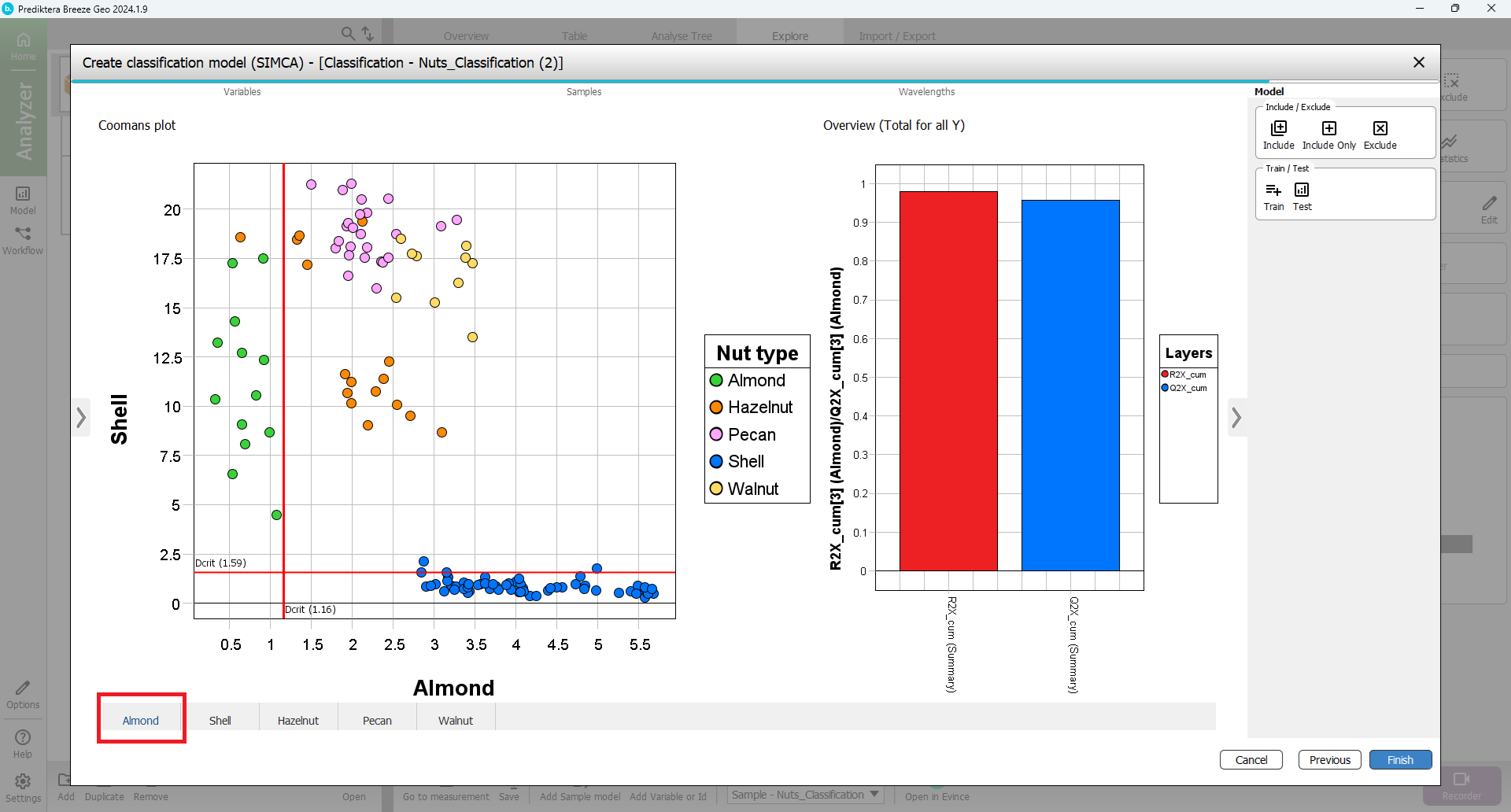
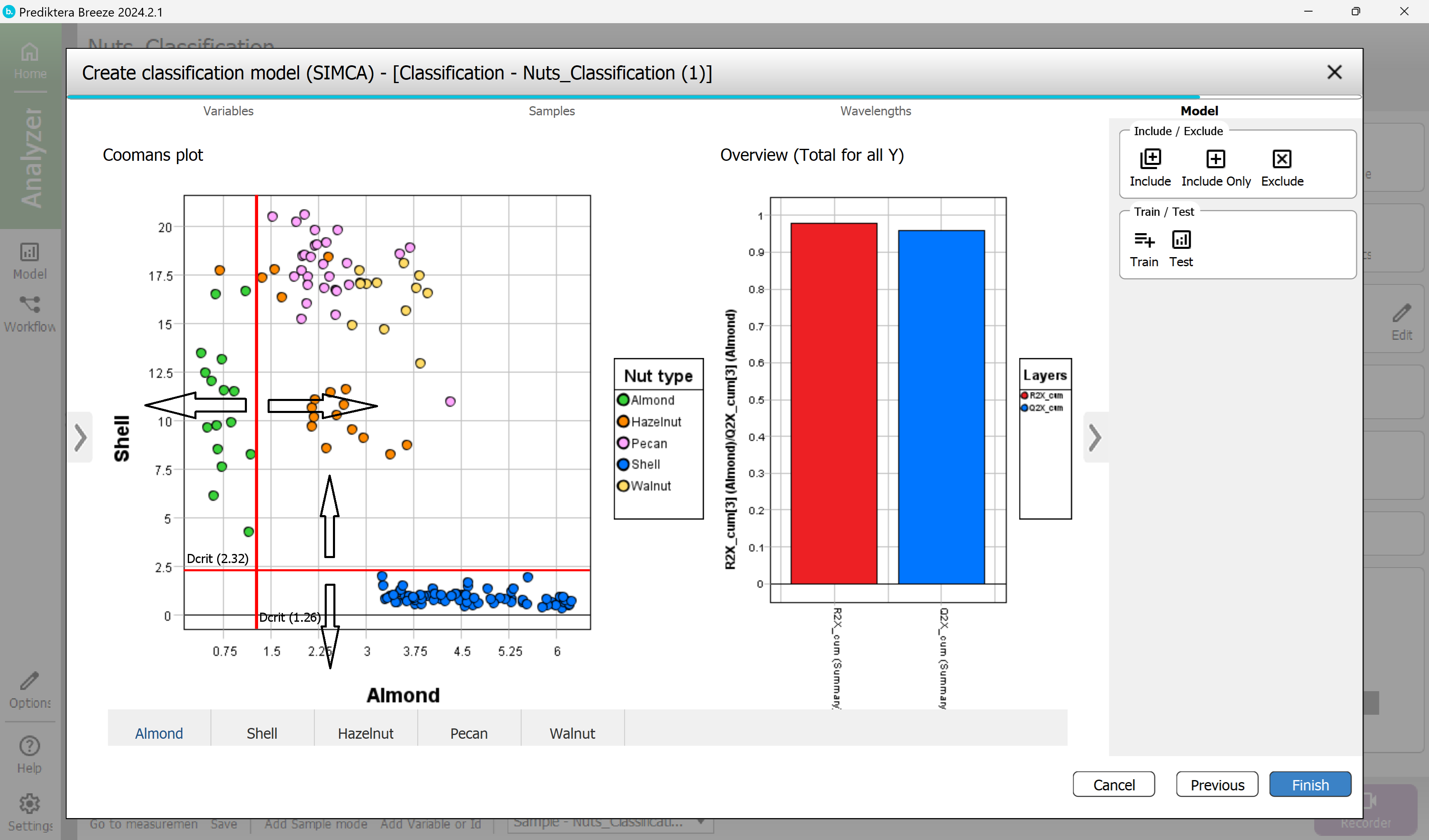
Press the “Classification” tab to see how well the samples in the training data were classified.

Press the arrow to maximize the table view and the arrow to open the preview image.
Click on a field in the table to see the corresponding samples in the preview image.
In this example, with the SIMCA classification a total of only 1 samples were misclassified (you might get slightly different results depending on how you set the critical distance in the previous step). This can be compared to 14 misclassified samples for the PLS-DA.


Import the known class information for the test samples
To validate the model you should use an external test set to see how well it can classify samples that were not in the training data set. We will now add the known class information to the image “Mix” in the “Test” group.
Open the “Nuts_ Classification” project.
Select “Test” group
Select “Import” tab
Select “Import variables and id data”
Select “Nuts_Classification_Test_Samples.csv”
Press Next
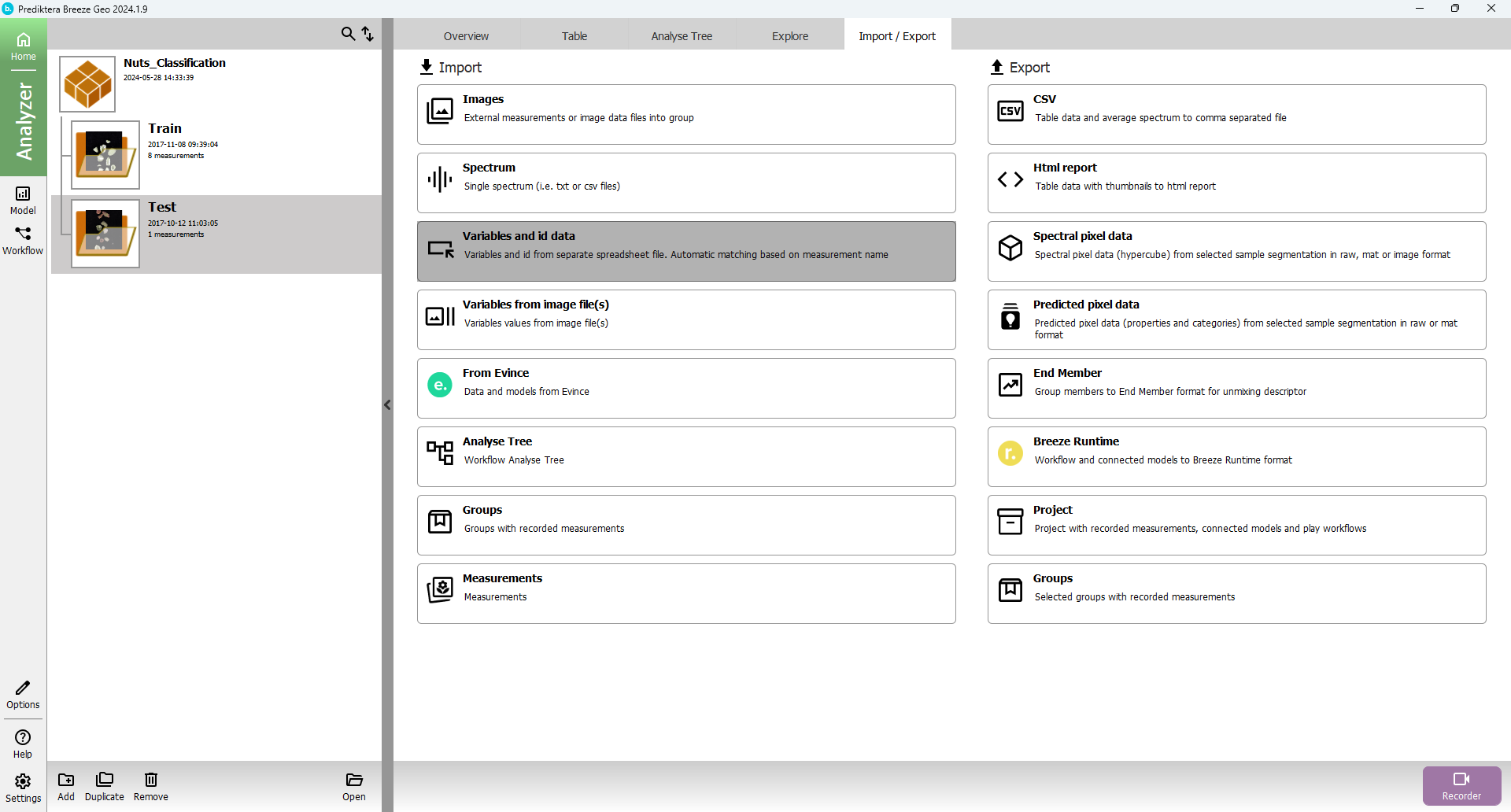
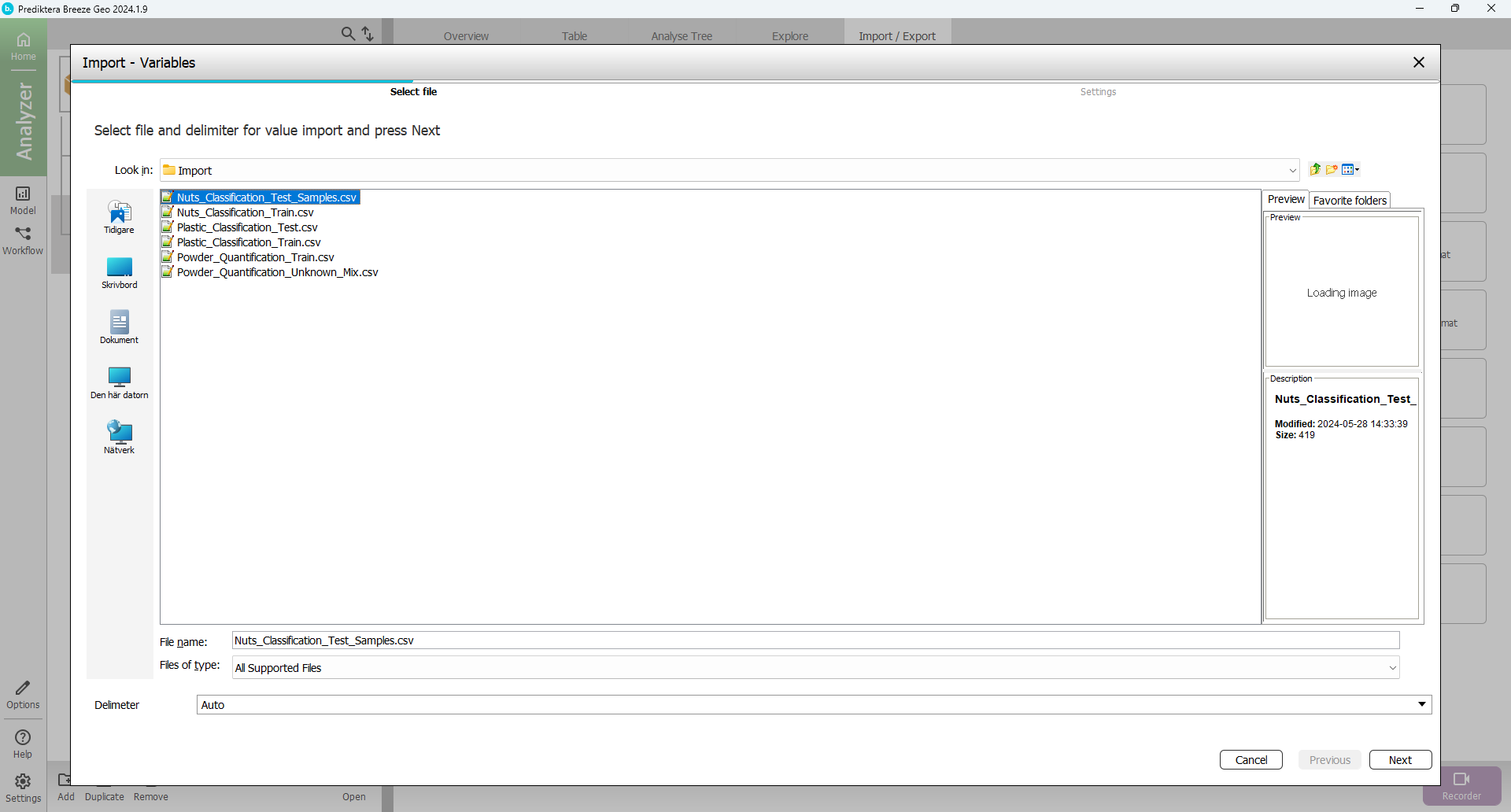
Use the default segmentation and…
Press “Finish”.
The table should look like this for the Test group.
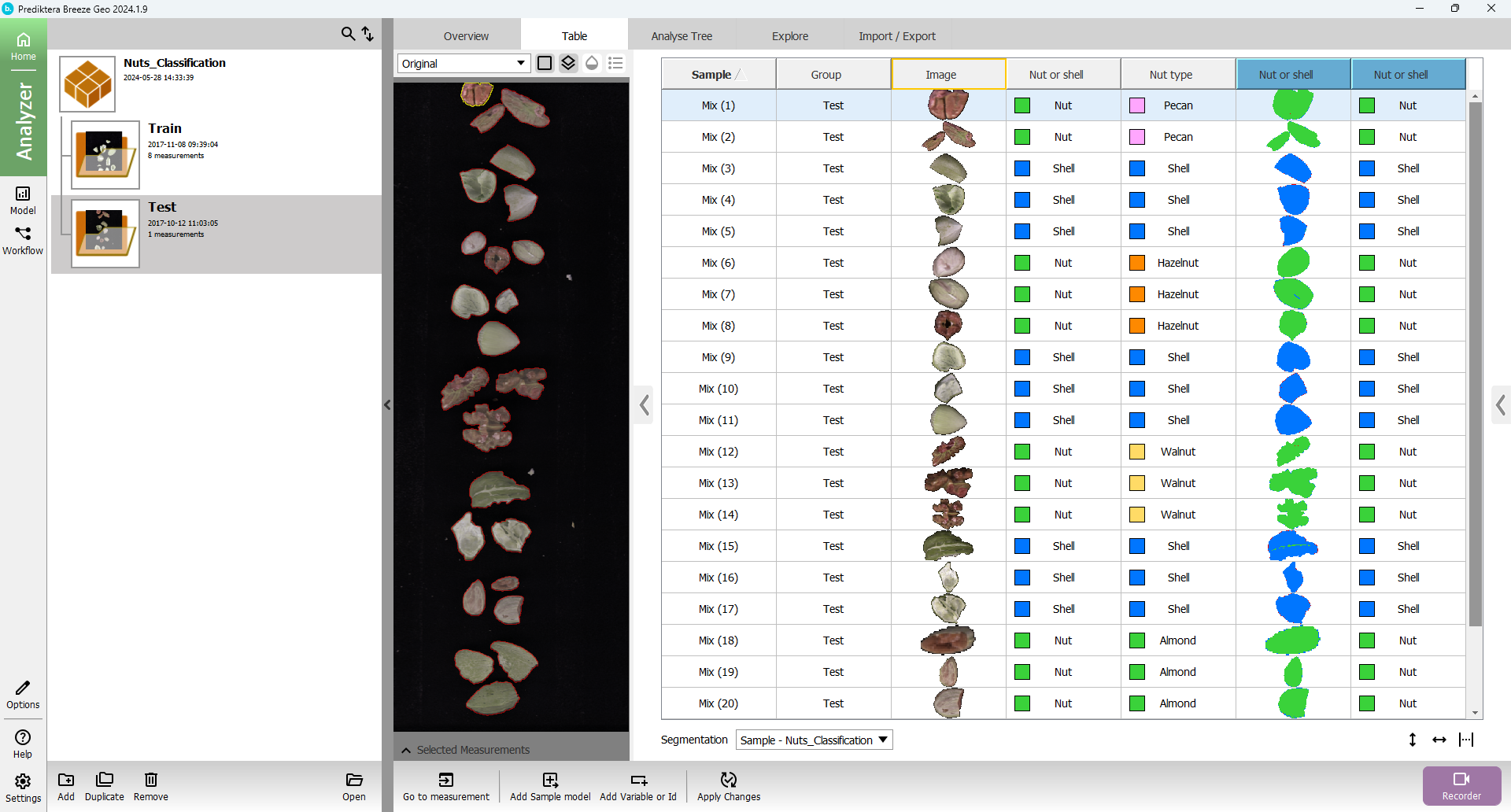
Press the “Model” button

and with the SIMCA model selected
Press Model options

Press the plus sign to Add “External Record Test Group”.
Make sure the group named “Test” is selected in the menu on the right.
Close the dialog
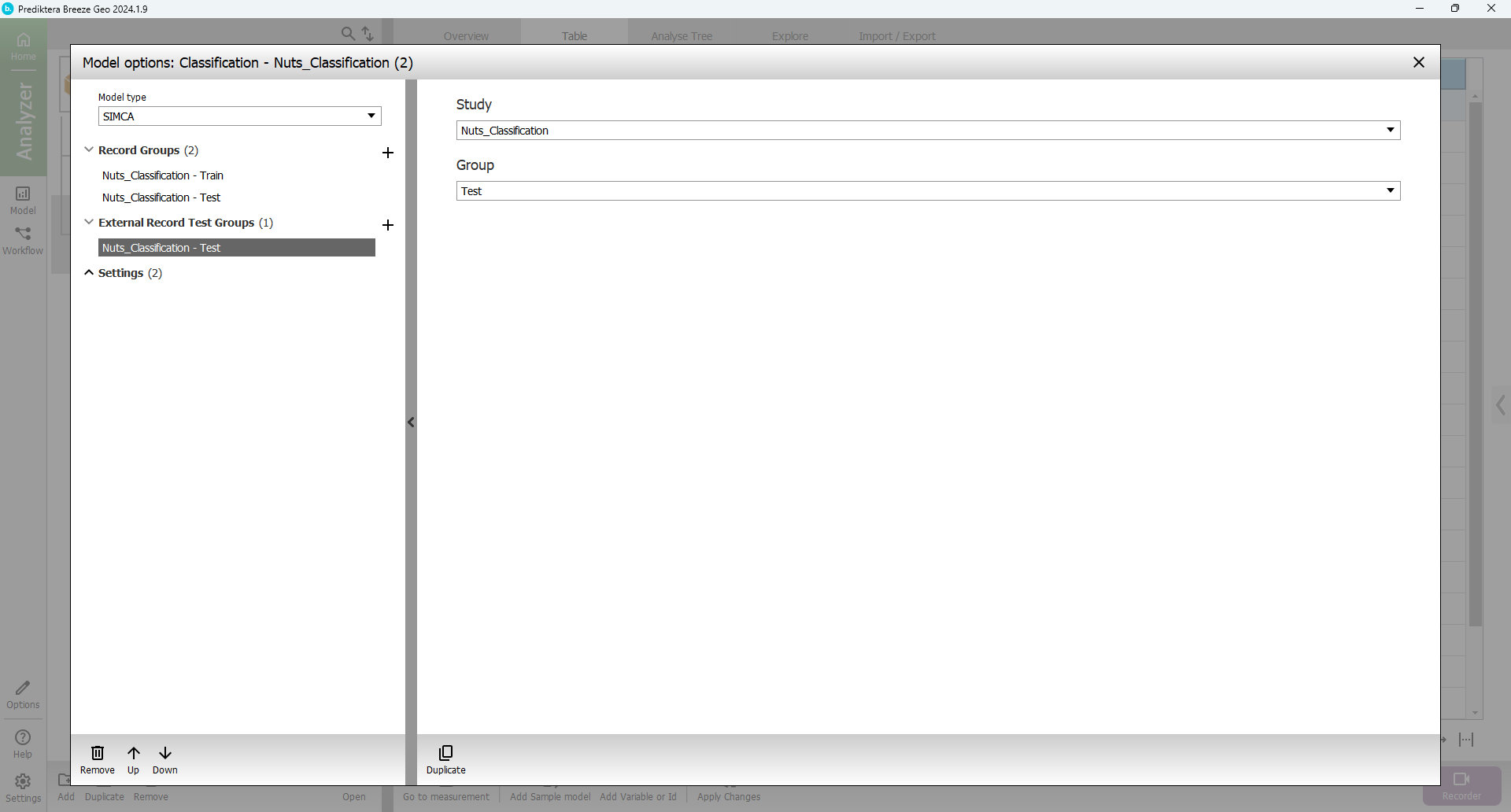
Press the “Classification” tab
Select “Test (External)” in the drop-down menu under the table.
You can now see how well the SIMCA model could classify the 23 samples in the “Test” group.
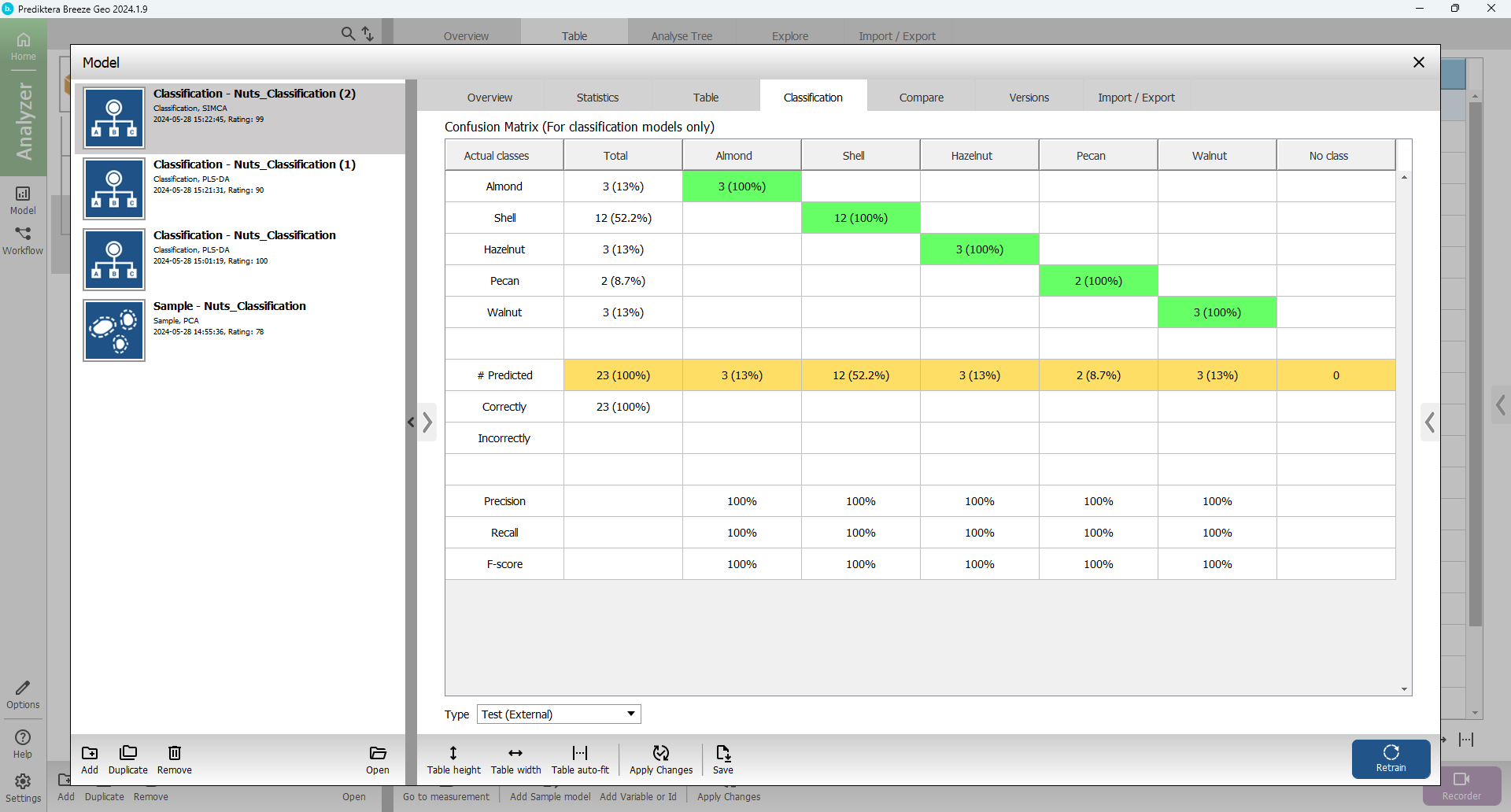
Let’s see how well the PLS-DA model can classify the test set.
Select the Classification - Nuts_Classification(1) PLS-DA model
Go to Overview tab
Press the plus sign to Add “External Record Test Group”.
Make sure the group named “Test” is selected in the menu on the right. ” (just like you did for the SIMCA model)
Press Classification tab
Select “Test (External)” in the drop-down menu under the table.

Create workflow and Import Record test data
Now let’s test the new models for Nut type in the Workflow mode.
Open up workflow

Press the “Add” button
Select “Record data” tab
Select the “Test” from drop down called Group
Press “OK”.
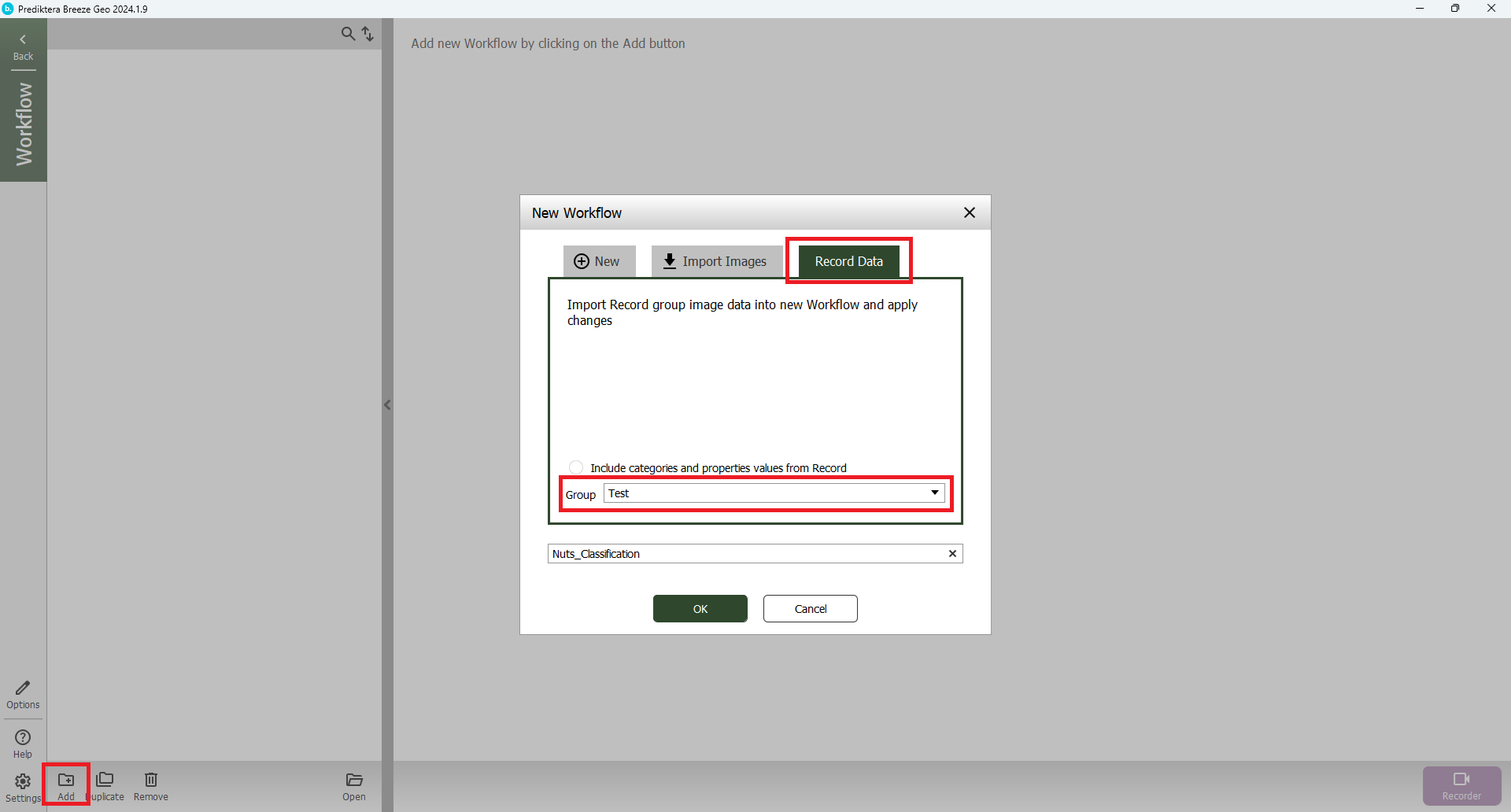
By default Breeze applies the latest model that you have in “Model” in the workflow.
In this case the SIMCA model.
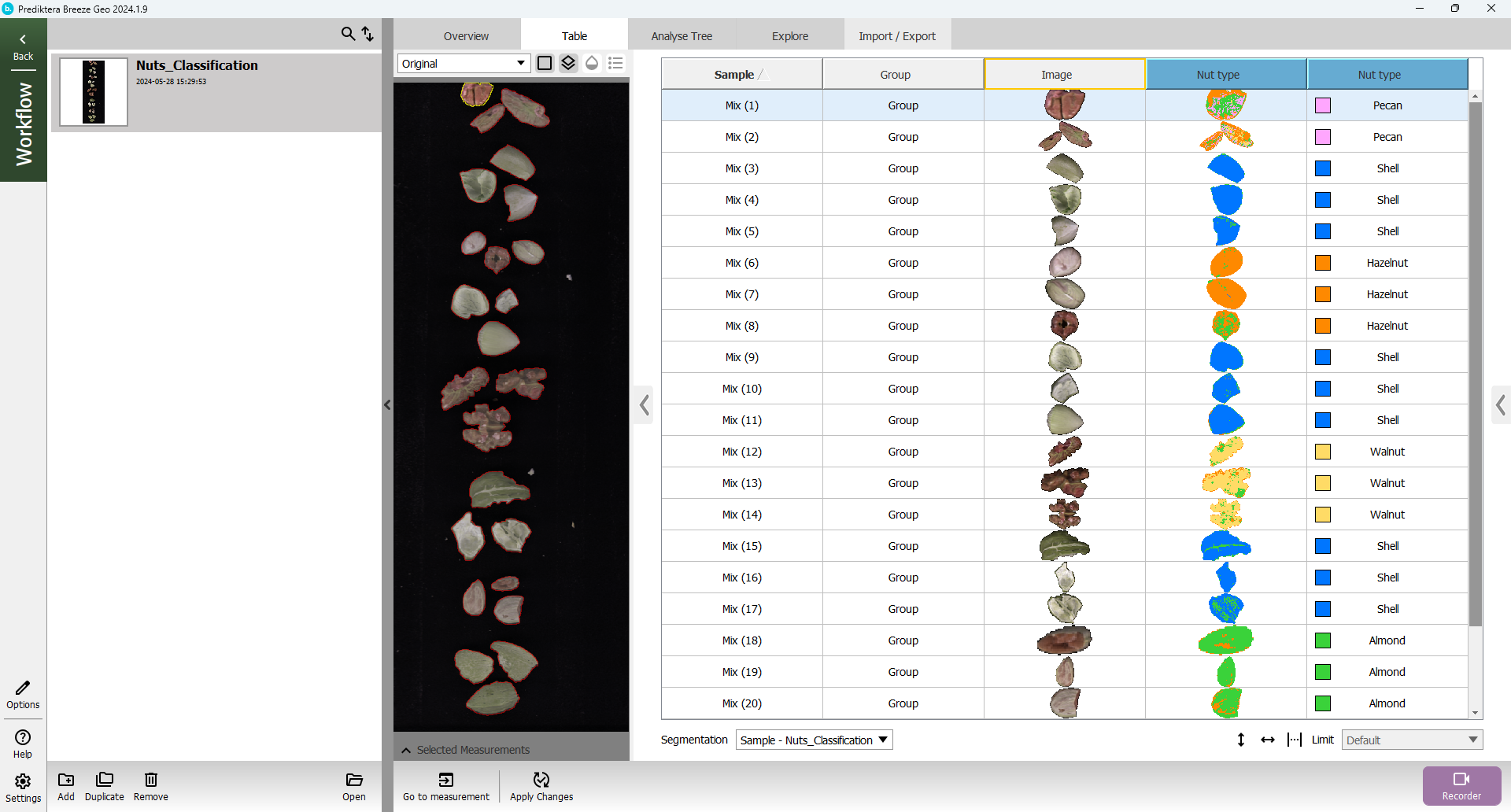
Go to “Analyse Tree” tab.
In the Analysis Tree, you can see the steps in the workflow from left to right.
First, the Measurement is analyzed by the Sample model that finds the samples (Object).
Each Object is then analyzed by our model and then classified into different classes.

Click on the blue symbol for the “Nut type” model (the model that classifies into the Nut or shell classes)
Press the “Duplicate” button below in the tool bar.
The “Nut Type” model has now been copied and added to the Analyse Tree.

Click on the first “Nut type” model to see the settings menu for that model on the right side (pull the vertical line to expand the size). In this menu, you can see the settings for the selected “Node” in your “Analyse Tree”.
In the “Model” drop-down menu you can see that this is the SIMCA model. So in the “Alias” field, write “SIMCA” and press enter on your keyboard.
Click on the 2nd “Nut type” model in the Analyse Tree and change to using the PLS-DA model in the “Model” drop-down menu. Write the Alias as “PLS-DA” and press enter. As you can see the text for each model has now been updated in the “Analyse Tree”.

In Breeze, you can add many different types of descriptors to your workflow. Click on the sample model in the Analyse Tree and then press the plus sign.
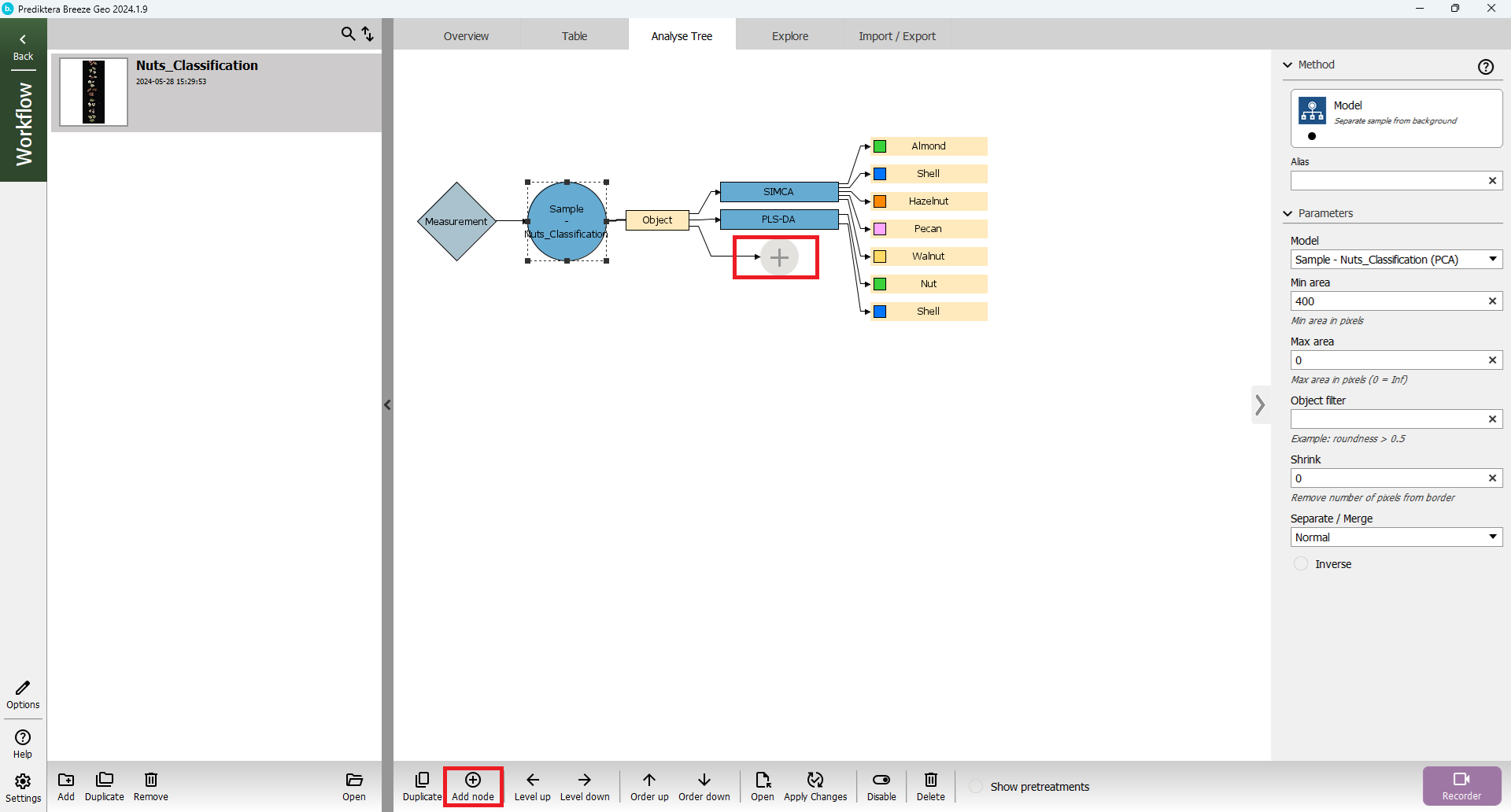
A new Node has now been generated as a subnode under the Object generated from the Sample model. In the “Add node” menu you can see the different types of descriptors that are available in Breeze. Select “Shape and size”.
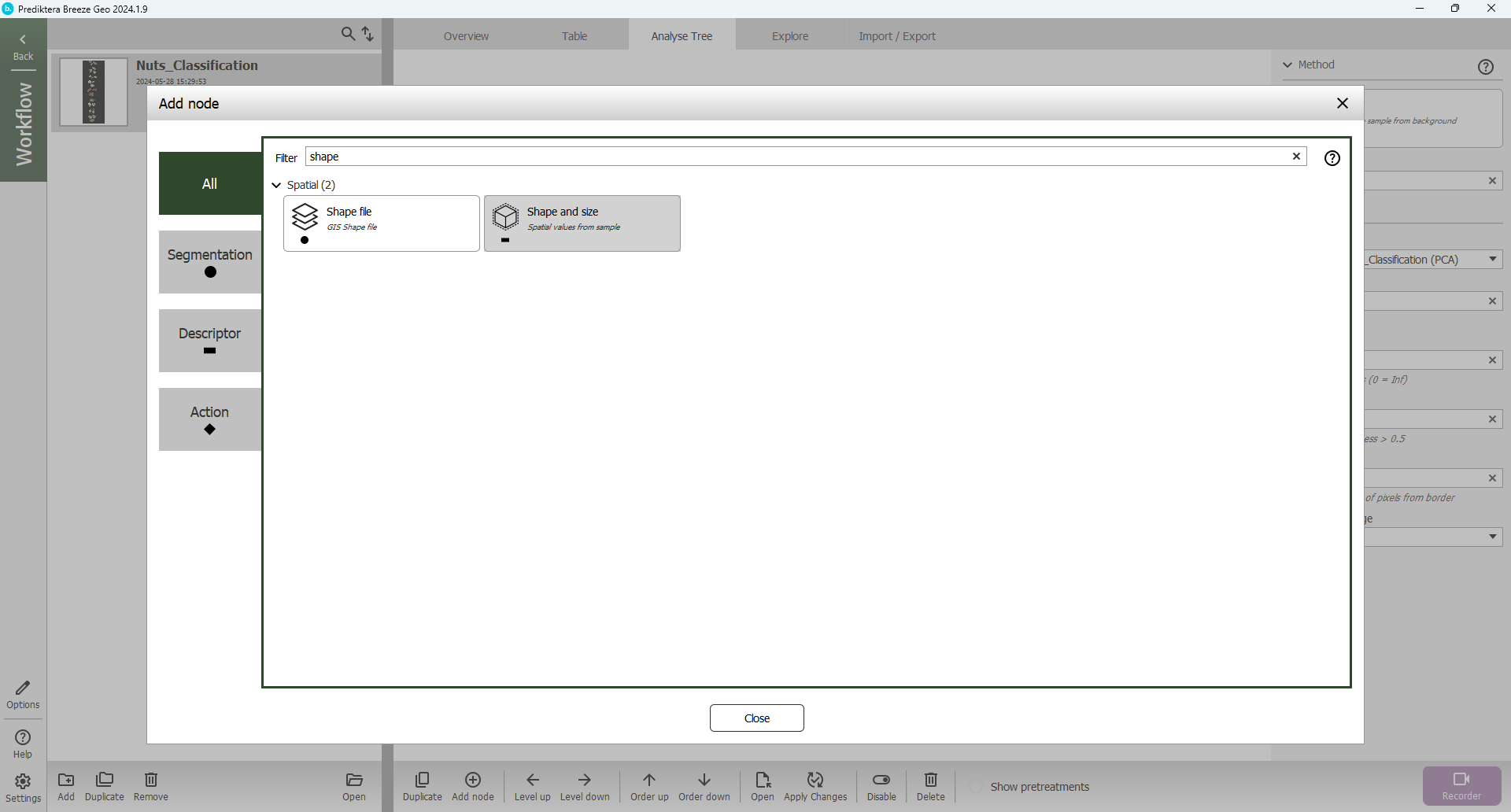
The default “Output” is “Area”.
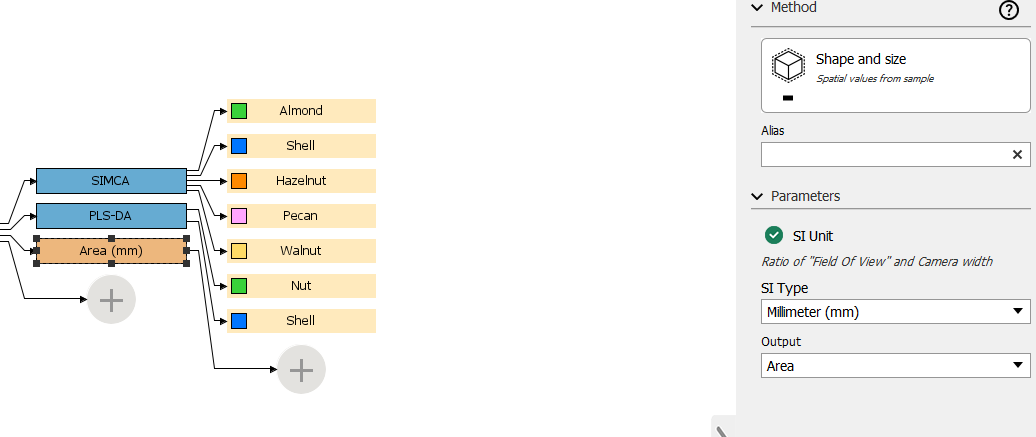
With the Area node selected in the Analyse Tree, press “Duplicate” and select “Width” in the “Output” menu. Press “Duplicate” again and this time select “Circumference”.
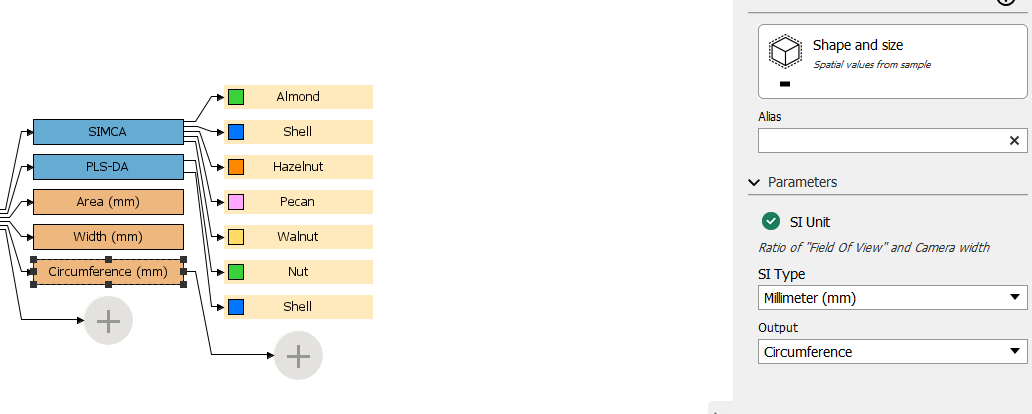
Select the Table view and then press “Apply Changes”

The “Table” should look like this after it has been updated to the new workflow (scroll the table to the right to see all columns, or reduce the “Table width” to fit them all on you screen.
To make more room for the table you can also remove the panel on the right by pressing on the chevron button.)
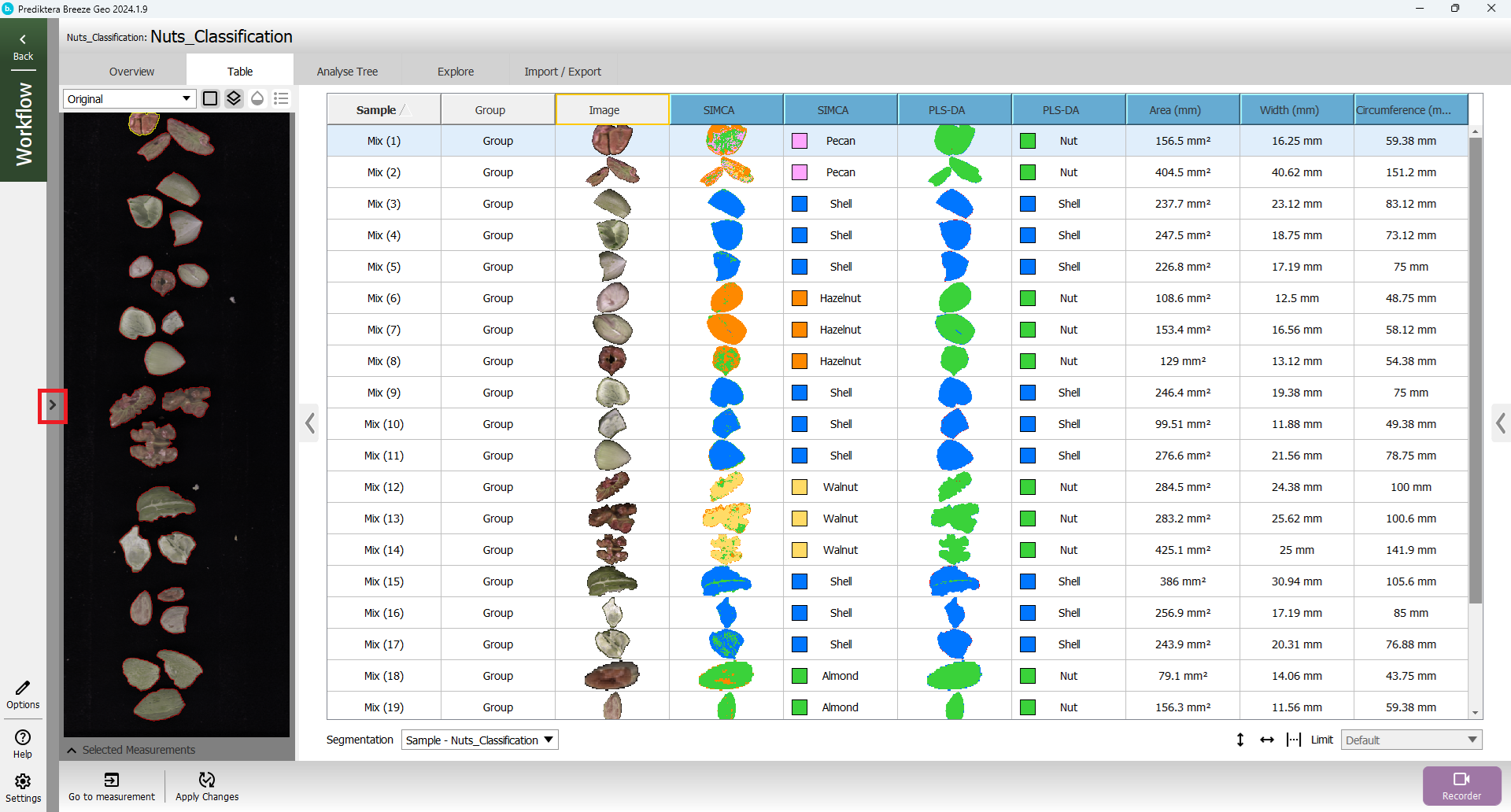
Nice job! You have reached the end of step 2 of the “Classification of Nuts” tutorial. See step 3 at:
